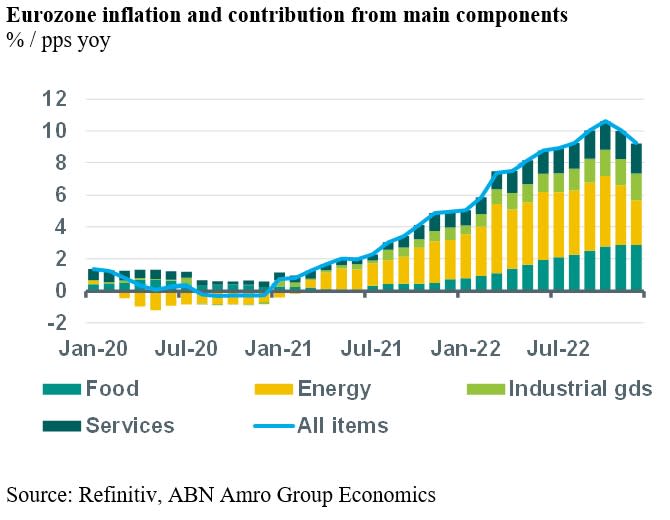Eurozone headline inflation drops lower, but core rises

Eurozone inflation fell to 9.2% in December, down from 10.1% in November. Again, the drop was entirely due to lower energy price inflation, which fell to 25.7%, down from 34.9% on the back of falling energy commodity price inflation, but also due to government policy measures, such as cuts in energy taxes and price caps. The drop in headline inflation masked a further rise in core inflation, to 5.2% in December, up from 5.0% in November. The rise in the core rate was a combined result of higher non-energy industrial goods price inflation (to 6.4%, up from 6.1%) and a further rise in services price inflation (to 4.4% from 4.2%). Headline inflation is expected to continue to decline noticeably in the coming months, but core inflation probably will be more sticky and decline more slowly.
Eurozone inflation fell to 9.2% in December, down from 10.1% in November. Again, the drop was entirely due to lower energy price inflation, which fell to 25.7%, down from 34.9% on the back of falling energy commodity price inflation, but also due to government policy measures, such as cuts in energy taxes and price caps. While food commodity prices have also fallen in recent months, the inflation rate of food, alcohol and tobacco increased to 13.8%, up from 13.6% in November. This increase seems to be due to past rises in energy and food prices being passed on to consumers with a delay, as unprocessed food price inflation dropped sharply lower (to 12.0%, down from 13.6%), while processed food price inflation increased (to 14.3%, up from 13.6%). We expect the declines in energy and unprocessed food price inflation to continue in the coming months, which should also reduce headline inflation further.

The drop in headline inflation masked a further rise in core inflation, to 5.2% in December, up from 5.0% in November. The rise in the core rate was a combined result of higher non-energy industrial goods price inflation (to 6.4%, up from 6.1%) and a further rise in services price inflation (to 4.4% from 4.2%). Headline inflation is expected to continue to decline noticeably in the coming months, but core inflation probably will be more sticky and decline more slowly. Lower food and energy inflation should also reduce the inflation rates of energy-intensive goods and services, but we expect this process to be slow, as past rises in food and energy prices still do not seem to have been passed on fully to consumers. That said, non-energy industrial goods price inflation should ease in the coming months, as these prices are mainly driven by global changes in supply and demand for industrial goods, which have become more balanced. On the other hand, services price inflation (with a weight of more than 60% in core inflation) is expected to remain more elevated. It is more domestically driven and more sensitive to wage growth, which is expected to increase in the next few quarters and decline only gradually in the second half of this year, as labour market prospects deteriorate. All in all, inflation should fall noticeably in the coming months, but we expect it to remain elevated at around 5% by the middle of this year.
